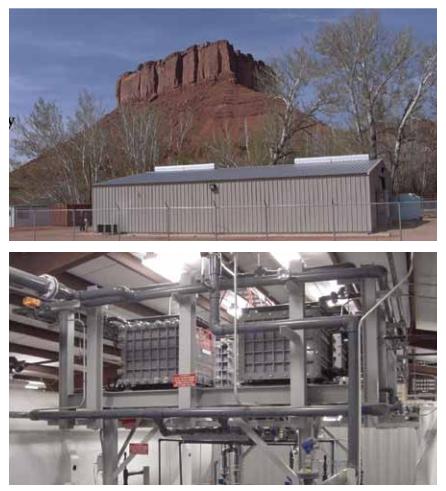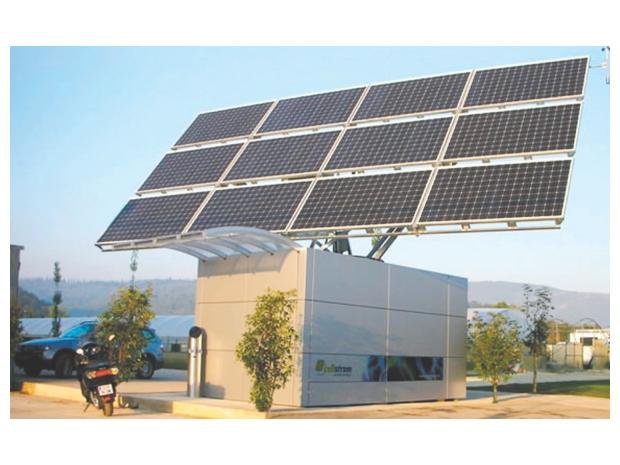Summary of Vanadium Redox Battery
Summary of Vanadium Redox Battery
Introduction
The vanadium redox battery is a type of rechargeable flow battery that employs vanadium ions in different oxidation states to store chemical potential energy. [1]The present form (with sulfuric acid electrolytes) was patented by the University of New South Wales in Australia in 1986. [2] Flow batteries always use two different chemical components into two tanks providing reduction-oxidation reaction to generate flow of electrical current. However, vanadium redox batteries just use one electrolyte, dissolving V2O5 in H2SO4, to provide the potential redox reaction and the reversed reaction, allowing the battery to be circularly charged and discharged.
Properties
| Normal Capacity | 250MWh(Frequency Regulation)
4-40MWh(Utility) |
| Output Power | 50MWh(Frequency Regulation)
1-10MWh(Utility) |
| Energy Density | 15–25 Wh/L (54–65 kJ/L) |
| Power Density | 800W/h |
| Normal Charge and Discharge Duration | 5hours(Frequency Regulation)
4hours(Utility) |
| Response Time | 0.001-0.02s |
| Lifetime in Years | 15-25 |
| Lifetime in Cycles | >10000 |
| Roundtrip Efficiency | 65%-75%(Frequency Regulation)
65%-70%(Utility) |
| Capital Cost Per Capacity | 620-740/kWh(Frequency Regulation)
750-830/kWh(Utility) |
Applications
The unique advantages of vanadium flow batteries bring a wide use of use for applications.
1. Wind Energy Market
Currently wind turbines require power with its power is roughly equivalent to 1% of the lead-acid battery for protecting fan blades in emergencies. Additionally each wind turbine is equipped with required power approximately equivalent to the power of 10% to 50% of the dynamic storage batteries. For the fan off the grid, you need a larger proportion of the dynamic storage batteries. In the future, the vanadium battery can replace the existing lead-acid batteries to build a dynamic energy storage systems of wind farms.
2. Electricity Regulations
The main methods of power peaking regulation has been pumped storage power station. Due to the pumped storage power station built on two reservoirs by large geographical conditions, the construction is not easy to be built in the plains with large area and high cost of maintenance. Vanadium battery energy storage power station can be built without geographical restrictions, with small area and low maintenance costs. With the development of vanadium battery technology, the vanadium battery energy storage power station will gradually replace the pumped storage power station, play an important role in the power peaking regulations.[3]

Figure 1. Utah state PancifiCorp 2 MWh VRB-ESS systems.
3. Photovoltaic Power Station
As the name suggests, photovoltaic power generations need solar. There is no electricity generated in the evening and on rainy days, thus the demand for energy storage batteries arise. Due to the existing lead-acid batteries’ capacity and lifetime are very limited, vanadium in a photovoltaic cell as energy storage battery will be a good choice.[4]

Figure 2. Cellstrom Austria 100 kWh vanadium off-grid energy storage battery charging station
4. Electric Vehicles Battery
Vanadium redox batteries are suitable for electric vehicle power supply due to its huge charge acceptance ability to adapt to fast high-current charging and high current depth of discharge, high power density. it can be solved caused by vehicle emissions air pollution problems.
5. Uninterruptible Power Supply and Emergency Power Supply
UPS can not be only used as office buildings, theaters, hospitals, emergency lighting and other places, but also can be used as a computer, and some military equipment standby power.
Advantages
1. The cell output power depends on the size of the stack, depending on storage capacity and concentration of electrolyte reserves, so its design is very flexible, Given a certain output power, we can increase storage capacity, as long as the increasing of the electrolyte storage tank volume or increasing electrolyte concentration.
2. Vanadium batteries’ active materials present in the liquid, and there is only one ion electrolyte. That there is no charge and discharge of other ions, which results in a long lifetime than other options of batteries..
3. The charge-discharge performance is good, and the depth of discharge cannot damage the battery.
4. The self-discharge is low and there is no self-discharge phenomenon in the tank of electrolyte-free when the system is on off station.
5. Vanadium battery system can be fully automated closed operation, and there is no pollution with easy maintenance and low operating cost.
6. It is safe due to no potential explosion or fire hazard.
7. Battery parts are mostly inexpensive carbon materials, engineering plastics, which are easy to recycle. There is no precious metal as an electrode catalyst.
8. With high energy efficiency up to 70%.
Disadvantages
- The energy density is low, the current energy density of advanced products is only about 40Wh / kg with the difficulty in storing and handling large volumes of the (somewhat corrosive) liquid electrolytes.
- The current international advanced level of the operating temperature range of 5 ° and 45 ° C, which is very strict to adjust when the temperrature is too high or too low.
- The system requires the using of expensive ion-exchange membrane, which can contribute more than 40% of the overall battery cost.[5]
Conclusions
According to the above advantages of vanadium redox batteries, the vanadium redox battery is a good method to store energy and it can be used in many areas. It has been installed in many countries in wind power, electric vehicles, PV system and UPS. It is developing now and it still face so many problems and disadvantages. Maybe in the future we can solve the problems of the disadvantages. The vanadium redox batteries will develop better and play more significant role in the stage of future energy.
References